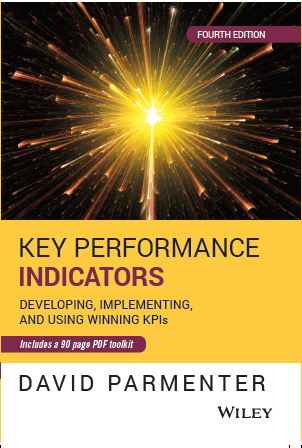Your cart is currently empty!

Quick links related to David’s KPI work
The FREE 120-page PDF toolkit for book owners
This book comes with a 120-page PDF toolkit comprising templates, checklists and worksheets for the KPI team on their important journey.
You can purchase the electronic version of the book exhibits and the PDF templates, checklists and worksheets plus useful PowerPoint presentations from the link below. For more information about the book, click on the book cover link.
David’s intellectual property is constantly evolving and to access his up to the minute KPI work it is best to purchase his extensive implementation guide that comes with E-templates. On notification of a purchase, David reviews the guide, updating it, and then publishes, ensuring that the reader receives his most recent thinking.
A guide to implementing KPIs in your organisation from the King of the KPIs
Seven reasons to buy David Parmenter’s fourth edition of Key Performance Indicators ……..
1. David Parmenter’s first edition of Key Performance Indicators was the first book to bring to light three discoveries to unlock performance measures from their shackles.
- An organization operating without its critical success factors, known by all, is aimless
- Most measures are not in fact KPIs they are result indicators – measures that show how teams have worked together, often measured monthly leading to a busy reporting machine that fails the organization
- All KPIs are non-financial, measured 24/7, daily or at the very least, weekly.
2. This fourth edition has been further refined to help project management professionals, senior leadership, and external KPI facilitators implement a successful KPI project. The book includes:
- The seven characteristics of KPIs and why you only need up to 10 KPIs
- The difference between result and performance indicators
- Getting the right mix of past, current and future measures
- A kit to help you find your organization’s critical success factors, the source of all meaningful measures
- The myths driving current measurement thinking that need to be avoided
- How to minimize the dark side of performance measures
- How rules to follow when designing performance measures from the CSFs
- How the in-house KPI team should sell and lead a KPI project
- A PDF implementation guide full of worksheets, checklists, and questionnaires for the KPI team
- Over 200 carefully designed performance measures (these can be purchased electronically in a database)(boxes)
3. If you are building KPIs for your organization, Key Performance Indicators will help you avoid these common mistakes and ensure you’re your efforts result in ownership, empowerment, and fulfilment at all levels.
Rife with examples, worksheets, practice exercises, templates, and other valuable tools, Key Performance Indicators is truly a field guide. Readers will walk away with an understanding of the what, why, and—most importantly—the how of building appropriate and effective KPIs into organizations of all sizes.
Key performance indicators are crucial to defining and tracking your organization’s progress toward its goals. Setting up the wrong performance measures can lead to unwanted behaviors across an organization, perhaps even destroying value through misalignment and confusion.
4. This fourth edition has been improved by:
- Simplifying, reorganizing and refining the Winning KPI process into a three-stage process
- Refining the “selling the change” process by incorporating more reference to the psychology behind resistance to change.
- A new chapter on the rules for designing measures
- New methods he has used in more recent KPI implementations
- A further refined performance measures database
5. All exhibits in the book + additional PowerPoint presentations
In the book and the accompanying PDF implementation guide, I have many exhibits, templates, checklists, worksheets, a PowerPoint KPI sales pitch, one-page KPI report formats to help the KPI team implement change rapidly. Readers will find it cost-beneficial to purchase the electronic versions, thus avoiding a time-consuming formatting exercise. As I only make USD$1.50 per book, I need to sell the electronic versions as they represent over USD$30,000 of my time over the years I have developed them.
6. Contents of the E-templates include
- Indicative KPI roll-out time frame template
- Agenda and content of a two day critical success factor workshop
- The workshop exercises
- Sphere of influence mapping template
- KPI reporting formats
- Questionnaire on employees’ view on KPIs
- Employee concerns and learning issues worksheet
- Agenda for staff roadshow to promote KPI project
- Marketing the KPI system to all employees checklist
- Half-day workshop timetable for the senior management team to sell the KPI project
- One day KPI focus group on CSFs and associated performance measures
- One day focus group agenda and timetable
- Senior management team commitment checklist
- Senior management team questionnaire
- Selecting a facilitator checklist
- KPI development strategy checklist
- KPI development strategy worksheet
- The KPI project facilitator’s role checklist
- Establishing a KPI project team checklist
- Establishing a KPI project team questionnaire
- KPI 360-degree questionnaire
- “Just do it” KPI project checklist
- “Just do it” KPI project worksheet
- Job description for the KPI team leader
- Workshop preparation checklist
- Draft of the CEO invitation to attend the two day critical success factors workshop
- Preparing a list of draft operational success factors checklist
- List of common operational success factors
- List of common outcome statements
- Agenda and timetable for a two day critical success factor workshop
- Instructions for the break out exercises in the critical success factors workshop
- A list of empty words sourced from Stacey Barr’s work
- Wording of measures exercise template
- Characterizing measures template
- Proposed agenda for the staff KPI workshop
- Exercises in the staff KPI workshop
- Understanding of the organisation’s critical success factors worksheet
- Checklist to ensure you have a successful staff workshop
- Key tasks for recording performance measures
- Checking KPIs against the seven characteristics
7. The PowerPoint E-templates
- A strategy PowerPoint slide deck
- Selling the KPI project to the CEO
- Selling the KPI project to the staff in your organisation
Readers comments
“
I am reading your book about the “Winning KPIs” and wanted to say it is great. The insights are very revealing, and the book is written in a very accessible language. Thank you for writing it. Again, thanks for bringing us this great book.”

Readers may be interested in David Parmenter’s implementation guides (whitepapers + E-templates)
David’s intellectual property is constantly evolving and to access his up to the minute work it is best to purchase his extensive implementation guides. On notification of a purchase, David reviews the whitepapers, updating them, and then publishes. Ensuring that the reader receives his most up to date thinking. For more information, you can browse the toolkits below.
- KPI implementation guide (SMEs <100 FTEs) – 180 page PDF whitepaper + e-templates +KPI database
- KPI implementation guide (SMEs 100-250 FTEs) -Whitepaper + e-templates + KPI database
- KPI implementation guide (Orgs Over 250 FTEs) – 180 page PDF whitepaper + e-templates + KPI database
- Moving to a lean finance function – A Journey Worth Making (120 page paper + electronic media)
- How to Implement Quarterly Rolling Forecasting and Quarterly Rolling Planning – and get it right first time (100 page paper + electronic media)
- How to Implement a Forecasting and Planning Tool – and get it right first time (110 page paper + electronic media)
- An Annual Plan in Two Weeks or Less (80 page paper + electronic media)
- Rapid month end reporting by day three or less and error free (120 page paper + electronic media)
- Reporting Informatively & Error Free – Decision Based Reporting Templates (90 page paper + electronic media)
- The twenty major mistakes corporate accountants make every year (100 page paper + electronic media)
- 20+ System Improvements for the Finance Team (80 page paper + electronic media)